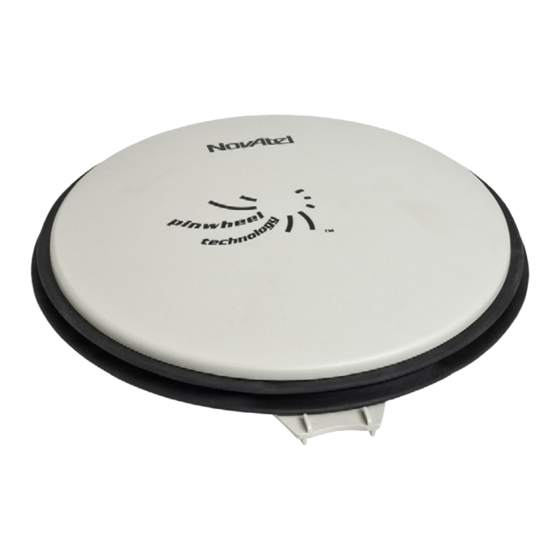
Table of Contents
Advertisement
Quick Links
The GPS-704-WB is an active antenna that can receive signals from GPS, GLONASS, BeiDou and Galileo
satellites as well as L-Band signals. It is designed to operate at the following frequencies:
•
GPS L1 (1575.42 MHz), GPS L2 (1227.60 MHz) and GPS L5 (1176.5 MHz)
•
GLONASS L1 (1593 - 1609 MHz), GLONASS L2 (1238 - 1254 MHz) and GLONASS L3 (1202 MHz)
•
Galileo E1 (1575.42 MHz), Galileo E5a and E5b (1164 - 1215 MHz) and Galileo E6 (1260 - 1300 MHz)
•
BeiDou B1 (1561 MHz), BeiDou B2 (1207.14 MHz) and BeiDou B3 (1268.52 MHz)
•
L-Band (1525 - 1560 MHz)
This guide provides the basic information you need to install and begin using your new antenna.
ADDITIONAL EQUIPMENT REQUIRED
The equipment listed below is required to set up a GPS-704-WB antenna:
•
A mount, such as a range pole, tribrach or tripod, with a 5/8" x 11 thread that extends between 3/8" and
7/8" (9 mm and 22 mm)
•
A 1" open-end wrench
•
Coaxial cable with a male TNC connector
•
A device with an antenna input port that both receives the RF signal and provides 4.5 - 18.0 VDC to the
antenna. (All NovAtel GNSS receivers provide the necessary power through their antenna RF
connectors.)
SITE SELECTION GUIDELINES
Before installing the antenna, select a site that as closely as possible meets the following conditions for
optimal performance:
•
An unobstructed line-of-sight from horizon to horizon and at all bearings and elevation angles.
•
As far as possible from reflective objects, especially those that are above the antenna and any water
bodies, which can be a strong source of multipath reflections.
•
If obstructions and reflective surfaces are within 30 m, ensure the site is as high as possible. Otherwise,
mount the antenna as low as possible.
GPS-704-WB
USER GUIDE
GM-14915141
Rev 1
April 2015
1
Advertisement
Table of Contents

Summary of Contents for Novatel GPS-704-WB
- Page 1 GM-14915141 Rev 1 April 2015 The GPS-704-WB is an active antenna that can receive signals from GPS, GLONASS, BeiDou and Galileo satellites as well as L-Band signals. It is designed to operate at the following frequencies: • GPS L1 (1575.42 MHz), GPS L2 (1227.60 MHz) and GPS L5 (1176.5 MHz) •...
- Page 2 NovAtel GNSS receivers provide the necessary power through their antenna RF connectors. ANTENNA CARE The GPS-704-WB is designed to withstand the elements, including rain, snow and dust. However, to ensure your antenna performs optimally, keep the radome (the top surface of the antenna) clean and brush off any ice and snow.
- Page 3 ELEVATION GAIN PATTERN...
- Page 4 SPECIFICATIONS Radio Frequency Low Band: 1164 - 1300 MHz 3 dB pass band (typical) High Band: 1525 - 1610 MHz Out-of-band rejection (typical) L1 100 MHz minimum 30 dBc L2 200 MHz minimum 50 dBc GPS L1, GLO L1, Galileo E1, BeiDou B1: +5 dBic Gain at zenith (= 90°) (min) L-Band...
- Page 5 MECHANICAL DRAWINGS All dimensions are in millimeters (mm) where 1 inch = 25.4 mm VIEW Tape measure station Ø185 Ø170 SIDE 60.6 69.1 VIEW Height 194.5 = PHASE CENTER BOTTOM VIEW Height = Vertical phase center offset from antenna reference point or antenna reference plane (ARP)
- Page 6 NovAtel expects the phase centers of the GPS-704-WB to be comparable by design. If you need any further advice on this matter, visit our website at www.novatel.com. Other methods of contacting Customer Service can be found on the last panel of this guide.
- Page 7 Cables and Accessories: Ninety (90) Days Date of sale shall mean the date of the invoice to the original customer for the product. NovAtel's responsibility respecting this warranty is limited solely to product repair at an authorized NovAtel location only. Determination of repair will be made by NovAtel personnel or by technical personnel expressly authorized by NovAtel for this purpose.
- Page 8 WEEE NOTICE If you purchased your GPS-704-WB in Europe, return it to your dealer or supplier at the end of its life. The objectives of the European Community's environment policy are, in particular, to preserve, protect and improve the quality of the environment, protect human health and utilise natural resources prudently and rationally.















Need help?
Do you have a question about the GPS-704-WB and is the answer not in the manual?
Questions and answers